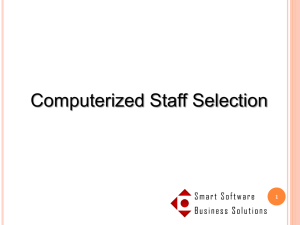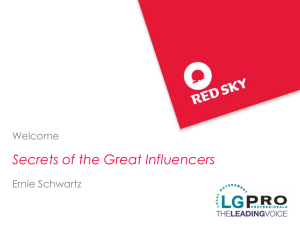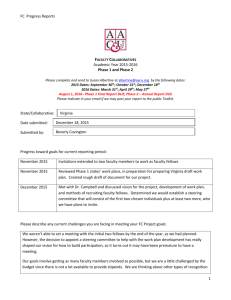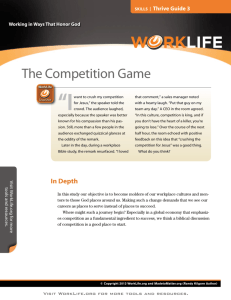A Customized Leadership development Program
advertisement
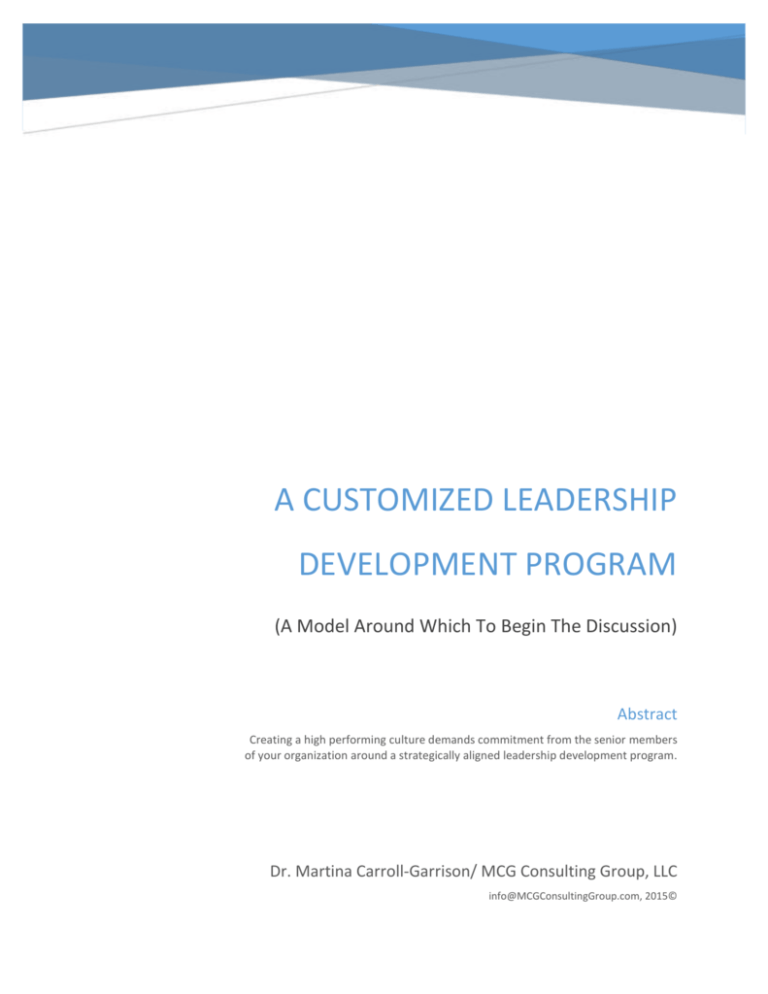
A CUSTOMIZED LEADERSHIP DEVELOPMENT PROGRAM (A Model Around Which To Begin The Discussion) Abstract Creating a high performing culture demands commitment from the senior members of your organization around a strategically aligned leadership development program. Dr. Martina Carroll-Garrison/ MCG Consulting Group, LLC info@MCGConsultingGroup.com, 2015© “… development programs need to be strategic and focus on real business issues. “Educational initiatives have to become far more customized and tightly integrated with the organization’s strategic agenda; their aim will be to build leadership capabilities while simultaneously facilitating progress towards critical strategic objectives” https://hbr.org/2010/06/time-to-shift-the-paradigm-of 1|Page www.MCGConsultingGroup.com 2015© High Performance Cultures Don’t Happen By Accident! A Leadership Development Program represents a significant tool for businesses striving to attract, motivate, develop and retain a competitive workforce, which will sustain a high performance culture. Creating such a culture demands a continuous and focused commitment from the most senior members of your organization. Envisioning, Building And Sustaining A High Performance Culture Depends Upon Two Conditions. The first condition is the preparedness of your leaders and influencers 1 to support the creation of high performance as a cultural norm. The second condition is the depth of passion and commitment of your leaders and influencers with regard to the three axes of your organization; including (1) your product, (2) your customers, and (3) your people. Developing and sustaining leaders and influencers who can master the disparate demands of these three axes is not easy. A Leadership Development Program aligned with your long-term business strategy can help ensure you have the people in place to drive a high performing culture towards creating superior business results. 1 For the purpose of this discussion “influencers” with the organization include (1) senior employees who are not serving in a leadership or management position, and (2) non-senior employees who are not serving in a leadership or management position, who by virtue of their position and inherent skills serve as a significant influence and ambassador within and for the organization. 2|Page www.MCGConsultingGroup.com 2015© What Are Other Organizations Doing About Leadership Development? Source: Leadership Development Program: Three Key Success Factors, by McNally, Christina. Leadership Excellence; Mar 2014; 31, 3; ProQuest Central pg. 17 3|Page www.MCGConsultingGroup.com 2015© Background The following concepts are presented for the benefit of HR Directors and Chief Learning Officers contemplating deployment or expansion of an internally developed and customized Leadership Development Program. The ideas below represent strategies for building consensus for, and socializing the benefits of your customized Leadership Development Program, as well as several considerations for designing and developing the structure, content, communication process, and metrics for success. “….. given the continuing evolution of HR as a corporate function. Traditionally, the HR function of a firm has stewarded leadership training and development as an area of activity ….Progressively, the HR function in many firms has evolved into a more far-reaching driver of corporate direction and behavior. As the HR function takes on this broader role as a strategic partner, it becomes an asset that offers a source of hard to imitate, competitive advantage … traditionally isolated HR practices such as leadership training and development, compensation administration, job analysis and design, and performance management, have become more tightly integrated into a coherent force that collectively can shape employee behavior in conjunction with clearly articulated statements of organizational core values, vision, and mission …. firms that have adopted this sort of strategic view of the role of the HR function are more capable of developing … holistic leaders ….” Human Resource Management Review 17 (2007) 427–441 2 This approach to creating a customized Leadership Development Program is based on three central assumptions. The first assumption pertains to each individual employee’s potential for professional success, while the second assumption pertains to the organization’s role in supporting the individual employee in being successful, and the third assumption pertains to the subsequent advantage to the organization’s business strategy as a result of helping the employee to be successful. 2 Developing holistic leaders: Four domains for leadership development and practice Scott A. Quatro a, ⁎, David A. Waldman b,1, Benjamin M. Galvin c, 2 4|Page www.MCGConsultingGroup.com 2015© Assumption #1: Throughout the typical career progression of each leader and influencer, several workplace and worklife hurdles will be encountered, which must be overcome. (Stated another way – in the worklife of each individual the workplace presents challenging conditions that must be successfully dealt with in order to progress professionally) Assumption #2: Both emerging and seasoned leaders and influencers can be supported by their organization in their learning about how to identify, navigate, and overcome these typical workplace and worklife hurdles. Facilitated learning accelerates problem solving and growth. Assumption #3: By identifying, and facilitating leadership development practices, ranging from (1) entry level or tactical, (2) mid-management level or operational, and (3) the executive or strategic level, your customized Leadership Development Program serves as a tool towards creating a high performance culture. 5|Page www.MCGConsultingGroup.com 2015© Setting The Stage The importance of socializing the benefits of and building consensus for a customized Leadership Development Program cannot be ignored. Prior to any program design or developing of the structure, you must first create an understanding of what are the specific needs of your organization. This step can be accomplished when you directly engage with the group of individuals holding the greatest level of influence in your organization. Specific to each organization are explicit and implicit wants, needs and desires towards creating superior business results. A suitable mechanism towards identifying organizational needs, all-the-while socializing the benefits of and building consensus for a Leadership Development Program, is the initial facilitated workshop. A facilitated workshop could include three pre-prepared artificats , (1) a workshop charter and agenda clearly linked to the longterm business strategy, (2) advance socialization of program benefits through preworkshop data collection (surveys and interviews), and (3) prescribed workshop outcomes for the way-ahead for launching a Leadership Development Program towards enabling superior business results. Strategy The success of any good plan is based on the measures that are laid out by the various stakeholders. The following seven strategies are presented for consideration towards building consensus while building and executing your customized Leadership Development Program: Strategy #1: Do your homework – create a succinct “needs” narrative which speaks to the experiences of your stakeholders, including sponsors, senior leaders and influencers. Intuitively we understand that each stakeholder’s workplace and worklife experience is both unique and complex, however career progression can be depicted 6|Page www.MCGConsultingGroup.com 2015© in simple terms. Part of your homework preparation includes assessing and understanding the respective career paths and challenges encountered by the program sponsors, senior leaders and influencers. Presenting a leader development program proposal against the backdrop of each leaders' personal career experiences will resonate with them (and create an emotional connection) and also begin to pave the way for commitment of resources necessary to support program deployment. The value of being able to say “….I’ve talked to most of you…I've listened to how you overcame workplace and worklife hurdles….I’m familiar with your current challenges…..I can appreciate your current worklife pressures….I am also deeply aware of the contemporary challenges facing our new employees and mid-level managers…..I am cognizant of how our industry, and more specifically our direct competitors address their professional development needs…" can not be overlooked. Strategy #2: Socialize the program- create a succinct “program” narrative with the language unique to your business and industry. Describe your Leadership Development Program within the context of your business SWOT – ranging from strengths and weaknesses within current operations, to opportunities and threats around the envisioned future state outlined in your organizations’ strategic plan. Make the program’s narrative relevant to the worklife of your stakeholders. Use language and activities that are familiar to the group and introduce learning platforms and methodologies currently employed or valued by your organization or industry. Your customized Leadership Development Program is designed to answer your organizations’ specific development issues, therefore using the organization’s current successful methodologies builds acceptance. Structuring the Leadership Development Program around easily understood career transition periods enables your stakeholders to rapidly identify relevant KSAs, and accept a program design corresponding to each set of leadership challenges. An easily understood leadership development architecture is the three-tiered progressive 7|Page www.MCGConsultingGroup.com 2015© and sequential model (Figure 1), which includes the (1) Aspiring Manager Program, (2) the New Manager Program, and (3) the Senior Leader Program. Figure 1 Tier #1: Aspiring Manager Program. This fundamental program addresses predictable organizational needs towards creating a pool of manager candidates, while providing tactical skills to first line supervisors for immediate use. Generating awareness of, and interest in, management positions also serves as an effective recruiting and retention tool, as new entrants into your workforce can envision a path to positions of greater seniority and influence across the organization. The Aspiring Manager Program offers an insight to how organizational expectations translate into daily operational challenges for managers. In addition to exploring the fundamentals of people-management, aspiring managers will take their first steps into developing self-awareness, awareness of others, and assessing their communication and decision-making style, as an avenue to evaluating 8|Page www.MCGConsultingGroup.com 2015© their suitability for more demanding organizational roles. The Aspiring Manager Program offers tactical skills while illuminating each participants' management suitability, and also serves as a self-screening activity for those employees envisioning a management career path. Coaching underpins the program and serves to enhance self-awareness and awareness of others towards positively pursuing desired business results. Another outcome of the Tier 1 program is the collection of data and awareness to support a subsequent career development discussion. Tier #2: New Manager Program. This mid-level program offers skill-building training and tools necessary to build a team, organize and delegate work, monitor progress, and provide effective feedback. The operational-level training offers a pragmatic solution to the deployment of new managers, and to help them quickly assimilate into their new role. The New Manager Program establishes your organizational benchmark for managers by creating a performance standard for management skills and competencies. Executive Coaching underpins the program and serves to explore behaviors and perspectives as impediments to superior business results. Tier #3: Senior Leader Program. This senior-level program offers strategic level training and development to the most senior leaders and influencers in your organization. The program offers an intensive, data-driven approach, designed to examine personal effectiveness and build leadership capacity and executive presence. Executive Leadership Coaching underpins the program and is inextricably linked to development of individual executive competencies while pursing superior business results. Executive Leadership Coaching is used as a professional development multiplier towards complex behavior change. Understandably, certain behaviors that helped you to become today’s successful manager and leader, may be standing in the way of tomorrow's professional advancement or superior business results. 9|Page www.MCGConsultingGroup.com 2015© Strategy #3: Identify and leverage internal sages, coaches, teachers and mentors. Aspiring, emerging, and practicing leaders can learn from internal sages, coaches, teachers and mentors. Identify and leverage existing capabilities towards accelerating growth and development. Capitalize on the connection between learners and other learners, as well as leaders and learners. Peer learning will strengthen organizational bonds and build competence and confidence for learners at the tactical and operational level. Leader learners from each higher level of leader development can also share their journey and insights with their more junior colleagues. Employing peer learning and leader learning mechanisms creates substantial linkage both horizontally and vertically within the organization. Deploying leader learners within lower learning echelons ensures greater alignment with the strategic vision and business strategy of the organization. Assessment of leader learner competencies will also offer opportunities for select individuals to serve as faculty, panel members, project mentors, and individual coaches and mentors. Additionally, second-hand learning from open training (i.e. leadership development programs), is accomplished by transfer to workplace colleagues, and supervisors and program participants can facilitate transfer of learning by actively encouraging relevant interactions of program graduates and their colleagues. Specifically, had a stronger relationship to transfer than closed training. Strategy #4: Employ your published strategic plan and business strategy as the program’s compass, and use the current performance indicators (and competitor threats) to steer discussions regarding program focus and allocation of resources. Your strategic plan envisions a future state, while your business and management strategy addresses the competitive and operational challenges of your 10 | P a g e www.MCGConsultingGroup.com 2015© marketplace. The leadership program’s competency model addresses the “what” and the “how” for your current and emerging leaders to be successful in meeting current and future business challenges and enabling superior business results. Intertwining your Leadership Development Program within the organizations’ strategic plan, and including program outcomes in the business strategy and management plan creates traction for and awareness of the programs’ potential, while simultaneously creating space on the financial ledger for recurring allocation of training and development resources. Strategy #5: Socialize and communicate your Leadership Development Program with your entire organization. A successful deployment of your Leadership Development Program has positive implications for all your employees (current and future). Employees – both current and potential ones will want to make informed decisions about hiring on with, remaining with, and growing with your organization. Allocation of program resources will be indirectly linked to the perceived value of the program from all quarters. Application to participate and approval of participants will require a complete understanding of the program and its linkage to the organization’s long-term business strategy. Line and staff personnel will have to make informed decisions about their own needs and the needs of others participating in the program; as some employees will require greater amounts of development resources than others towards achieving the organizations’ minimum competency levels. An implicit assumption about program participation is that merit, especially at the mid-level and senior level is a key differentiator. Supervisors and managers will need to be able to correlate employee performance reviews with current and future professional development needs. Directing significant training and development resources to higher performers beyond the aspiring leader level is consistent with building a high performance organization. 11 | P a g e www.MCGConsultingGroup.com 2015© Strategy #6: Don't become a martyr to the cause – begin building consensus early by first creating a steering committee. The first rule of creating your Leadership Development Program is to identify the significant consumers, supporters, and sponsors, and then establish a steering committee. Also assess and invite operations leaders and other staff leaders to serve on various workgroups. The steering committee make-up should be diverse and reflective of your entire workforce as well as the workforce and customer base in your industry as a whole. In addition to early socializing and consensus building there are additional reasons for employing a steering committee to assist in the creation of a customized Leadership Development Program. There are at least three other compelling reasons to work through a steering committee (and you will begin to identify more based upon the unique culture of your organization). The first reason is that the steering committee offers cultural and intellectual diversity, which mirrors your customer base, and which may be a significant factor if you are lagging behind your peer competitors in penetrating new markets. The second reason to employ a robust and diverse steering committee is to establish organizational relevance. Effective steering committee members from the operational side of the business will naturally lean toward business strategy decisions and resource allocation, which lend themselves to creating superior business results. The third reason refers back to Strategy #3. The purposeful activity of the committee offers a valuable secondary consequence, as it serves as a sorting mechanism to identify existing skills and capabilities among your workforce. Assessment of unidentified skills and leader learner competencies during steering committee meetings will offer opportunities to identify faculty, panel members, project mentors, and individual coaches and mentors to become part of your Leadership Development Program’s future instructional cadre. Strategy #7: The Elephant In The Room: How to answer the big ROI question about your Leadership Development Program 12 | P a g e www.MCGConsultingGroup.com 2015© Your Leadership Development Program represents a substantial investment of resources on behalf of your organization, thus the ability to articulate how you will measure the return-on-investment (ROI) is important from the outset. To begin to develop your ROI methodology it will serve you well to incorporate certain definitions into both the program’s charter as well as your subsequent calculations about the efficacy of the program. Definition #1: Leadership Confidence reflects self-assuredness in one's personal judgment and ability to lead and positively influence others internal and external to your organization. Definition #2: Leadership Competence reflects a combination of practical and theoretical knowledge, cognitive skills, behavior and values used to positively lead others within your organization, industry and customer base. Definition #3: Training ROI Satisfaction reflects a positive valuation of your training program relative to return on investment (ROI) provided; reflecting (1) increased skill capacity, (2) counteracting performance gaps, and (3) support of business goals. Quite simply, demonstrating a return on the investment for your Leadership Development Program will not be an easy task. Anecdotal evidence will serve as a significant indicator, as stories from the program’s participant’s offers tremendous power. Significance of the program can also be demonstrated by capturing and recording vignettes and accomplishments of successful program participants. However, there are two other qualitative mechanisms that can be successfully deployed to establish ROI. The first qualitative mechanism is an ongoing survey and assessment of each student’s Leadership Confidence and Leadership Competence. The second qualitative mechanism is more significant however, as it presents an insight to the organizations Training ROI Satisfaction metric. The specific goal of the Training ROI Satisfaction metric is to illuminate themes, describe 13 | P a g e www.MCGConsultingGroup.com 2015© constructs, and explore patterns of awareness and reaction to the Leadership Development Program. This approach will also lead to suggested improvements in instructional content and/or post-training activities and outreach. Theoretical Framework: The theoretical framework for addressing the leadership program outcomes would be the Kirkpatrick Four-Level Evaluation Model (1976). The selected model reflects a contemporary approach to the evaluation of training and supports delineation of four levels of training outcomes; including reaction, learning, behavior, and results. Conclusion High performance cultures don’t happen by accident! A customized Leadership Development Program represents a significant tool for businesses striving to create and sustain a high performance culture. Leadership development has emerged as a key business strategy for contemporary organizations within a highly competitive and global marketplace. Creating a high performance culture demands a continuous and focused commitment from the most senior members of your organization around the development of all personnel within the organization. A customized Leadership Development Program built by your staff and for your staff, and which is aligned with your long-term business strategy, can help ensure you have the right people in place to drive a high performing culture towards creating superior business results within a complex, diverse, challenging and global marketplace. 14 | P a g e www.MCGConsultingGroup.com 2015©



